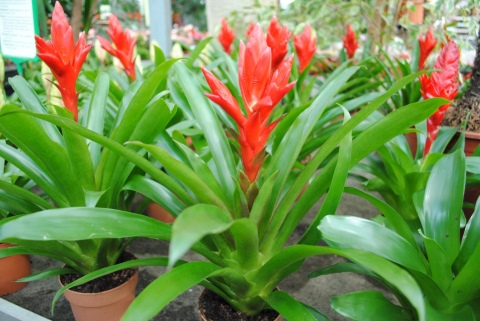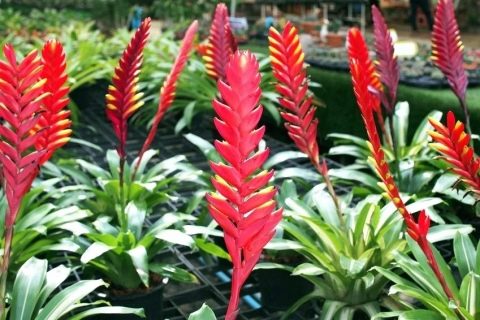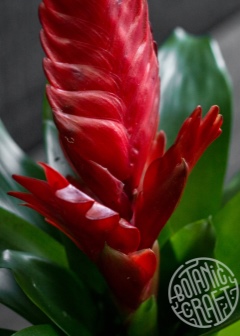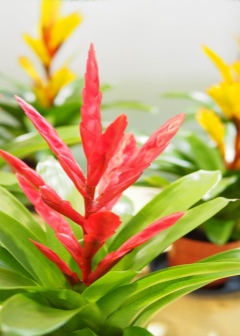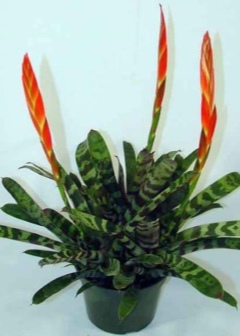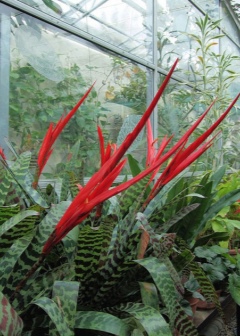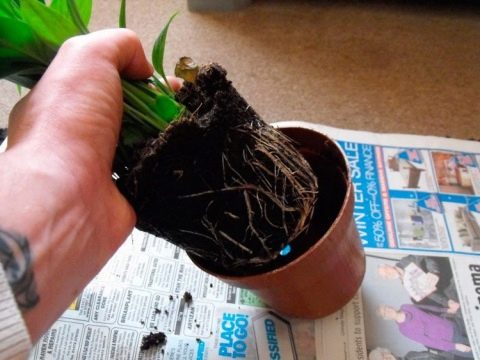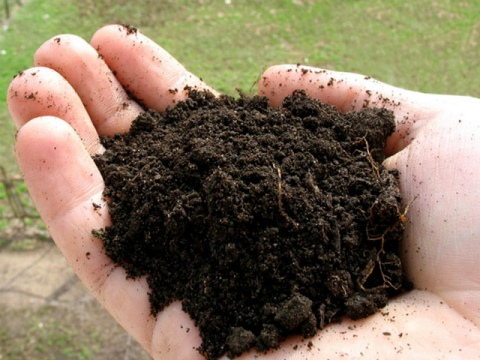Flower care
A place. The best arrangement of the flower is on the western or eastern windows. The plant loves diffuse weakened light, direct sunlight harms it. In the warm period, in the summer, during the hottest time - it is 11 ... 17 o'clock, the Frizee needs a shaded place. In bright light, the foliage of the plant fades. Those species of Vriezia that have thin and delicate or patterned foliage require better protection than representatives with more rigid and fat leaves. Vulnerable foliage can be burned.
Temperature. In summer, a fairly comfortable temperature for a flower is + 25 ... 30 degrees. In winter, for Vriezia, a temperature of 18 ... 20 degrees above zero is sufficient.
The important point is the temperature in the pot itself. There it should not drop below +18 degrees. Some people heat up the pots of the plant.
It is not recommended to purchase this beauty in the winter, it can complicate the process of adaptation to new conditions.
Top dressing. During the period of vigorous growth and development, it is necessary to make special preparations for feeding for Bromeliads. If there is a need, and there are no special preparations for this family, then they can be replaced with preparations for ornamental flowering plants in the calculation of ½ part of the dose. Recharge is carried out every 2 weeks, after soil irrigation. It is necessary to select high-quality fertilizers carefully for vriezia. In the composition of dressings, the nitrogen content should be reduced. Excess nitrogen and the presence of calcium in the soil have a detrimental effect on the plant.
Watering this flower is different from watering other indoor flowers. This is a special process. In summer, in the heat, pure water is poured into the groove of the leaves of the plant. It should be cleaned, softened, slightly warm. It is recommended to observe that the liquid does not linger. When it gets cold in a building or room, the water must be drained. In the warm season, the substrate in the flowerpot should always be moistened. It is necessary to prevent strong wetting of the rhizome.

When vriezia is fixed on a bromeliad tree, then every 10 days it is freed from the rack and placed in the standing purified water for some time so that the plant is filled with liquid. Then the Frizee is pulled out, the water is allowed to drain, and returned to its place.
In winter or in a cool room, you should not fill the groove of the flower with water. You need to water the substrate in moderation, gently, infrequently.
If the plant, after flowering in winter, will be in a well-heated room, then watering is carried out regularly, moderately, as the topsoil dries out. You can also add some water to the tank. Moreover, this should be done if the flower has bloomed again.
Air humidity. Should be at the level of 60-70%. To maintain such moisture in the air, it is required to spray vriezia twice a day.
But this must be done carefully so as not to get on the flowers, from moisture they become covered with brown spots.
If the flower grows in a pot, then it must be placed on a pallet with pebbles, moss or expanded clay. In this case, the bottom of the flowerpot should not come into contact with the liquid. The foliage is freed from dust with a damp sponge.
To maintain the desired moisture content around the plant, it is recommended to place the plant in a terrarium.
Any manipulation is carried out only with purified settled water or filtered, the temperature of which should be 2-3 degrees higher than the temperature in the room.
Reproduction
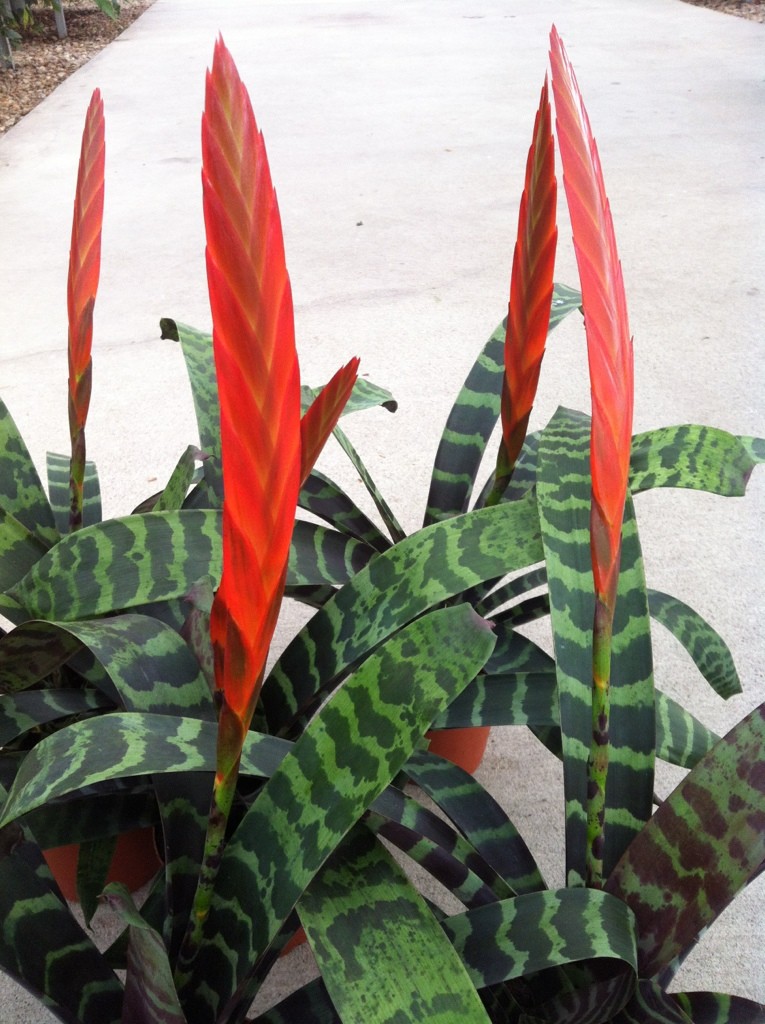
Reproduction of vriezia splenriet is possible in two ways - jigging babies and planting seeds.
It is very difficult and time-consuming to deal with seedlings, and efforts will not always be crowned with success. Sprouted seeds begin to bloom no earlier than 5 or even 10 years after planting.
Reproduction by children is a more reliable and reliable way to acquire a healthy and flowering plant at the optimal time. The “offspring” are formed immediately after the end of flowering - the mother flower dies off, the babies continue to grow.
They are selected and deposited after preliminary cleaning with a soft brush from the ground and then washing in water. Cut off the shoots from the flower with a sharp knife, sprinkle with coal and let dry, leaving for 24 hours.
Next, a baby is placed in a pot with a layer of drainage and on top of loosely poured soil. All are covered with a film to create greenhouse conditions for germination: the temperature is not less than + 25-27 ° C, the humidity is 70-80%. Then the vriese is placed in diffused sunlight. Plants planted in a vegetative way begin to bloom in 3-5 years.
Origin and description
Vriezia is one of the brightest and most decorative representatives of the bromeliad family. It is a herbaceous plant, an epiphyte that grows on trees. The habitat of Vriesia is the humid tropics of South and Central America, in particular the forests of Brazil and Argentina, as well as the West Indies.

Vriezia's vibrant sword-like flowers are incredibly attractive
The main feature of Vriezia is its unusual spike-shaped inflorescences on a peduncle, which in natural conditions reaches one meter. Very showy flowers are usually yellow or red, but sometimes there are species with an unusual color of greenish, snow-white, bright orange, as well as multicolored. You can admire the flowering of Vriezia for a very long time, its bracts last about 4–5 months, although flowers appear only for two weeks.
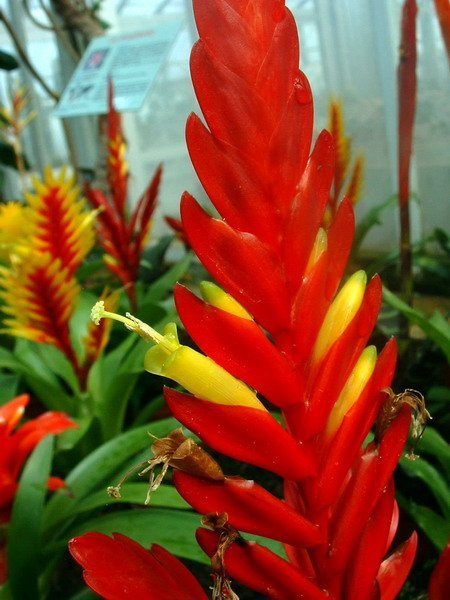
You can admire the flowering of Vriezia for a very long time, its bracts last about 4-5 months
The leathery belt-like leaf blades of the vriezia have smooth edges and a curved shape. As a rule, they are bright green, but some species have scales, specks and stripes of a contrasting shade. The leaves are collected in a funnel, in the center of which moisture accumulates, which feeds the plant.
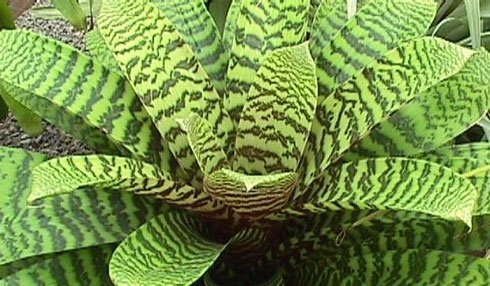
Vriezia leaf length - from 20 to 80 cm, width - up to 8 cm
The fruit of vriezia is a kind of box, within which there are seeds with wings, resembling a crest in shape. After ripening, the fruit bursts and the seeds fly apart. Vriezia dies, leaving offspring in the form of root rosettes (children).
In nature, the flower grows on other plants, so the roots serve exclusively for utilitarian purposes - keeping the vriezia on the surface of rocks, trees, stumps and snags. They practically lost the function of absorbing moisture and nutrients from the soil.
Vriezia perfectly adapts to room conditions and can be successfully grown not only in a greenhouse, but also in an ordinary apartment. She puts up with dry indoor air, and if you provide the plant with a suitable microclimate, it will multiply well and please with flowering several times a year.

Freesia and Vriesia are often confused, although they have nothing in common.
Vriese species popular in home floriculture (royal, brilliant, era, etc.)
Botanists have described about 250 species of Vriezia, 150 of which are grown in captivity around the world.
- Vriezia royal. The largest of the species. Due to its impressive size, the flower is not grown at home, but it can be found in greenhouses and botanical gardens. The leaf blades are collected in a rosette, their length is 1.5 meters, and their width is 18–20 cm. During the flowering period, the royal vriezia releases an arrow, the length of which reaches two meters. The bracts are pink and the flowers are yellowish.
- Vriezia is beautiful (brilliant). The homeland of this species is Guinea. The leaf blades are rigid, collected in a socket, shaped like a funnel.The leaves are painted in dark green tones and are decorated with transverse stripes of a dark purple hue, they can also be marbled, spotted or monochromatic, depending on the variety. The peduncle reaches a height of 1 m. The bracts are glossy, red-orange or bright red. The flowers are yellow.
- Vriezia is hieroglyphic. The habitat of this species is Brazil. The view is considered one of the most beautiful, thanks to the expressive arched foliage. The leaf blades, wide and shiny, are pale green with light yellow stripes. The panicle inflorescence reaches a height of 50 cm. The flowers are yellow. The bract is greenish, but there are hybrids with a bright yellow and red tint.
- Vriezia is keeled. The plant grows in the eastern regions of Brazil. The flower is small (the leaves are 15 cm long and about 2 cm wide). The leaves are monochromatic, painted in bright green tones, while the leaf blades located near the inflorescence are pinkish with a yellowish top.
- Vriezia astrid. The leaves are shiny, monochromatic, bright green. A distinctive feature of the variety is its inflorescence, similar to a bouquet of exotic flowers, painted in different shades from yellow to bright red. At the same time, about five peduncles appear on the plant.
- Vriezia is gigantic. The plant is quite large, therefore it is suitable for growing in greenhouses and conservatories. The leaves of Vriezia gigantea reach one meter in length. The inflorescence is multi-flowered, but "in captivity" this species blooms extremely rarely, and is valued for its expressive foliage.
- Vriezia era. The leaf blades of this plant are bright green, slightly turned outward. The peculiarity of the variety is the branched form of the bracts, colored in different shades from light red to purple.
The subtleties of planting and transplanting
When planting and transplanting, it is important to take into account the shape of the flowerpot, the type of soil, and several other nuances.
Choosing a flowerpot
A suitable container for planting vriese is a low one, up to 15 cm high, expanding upward. Too large a flowerpot should not be chosen, in volume it should be equal to the size of the root system of the flower.
Experienced growers advise choosing a ceramic planter, which will give the plant its resistance. Since the rosette of the vriezia is heavy enough and the roots are too small, an ordinary plastic pot can turn over.
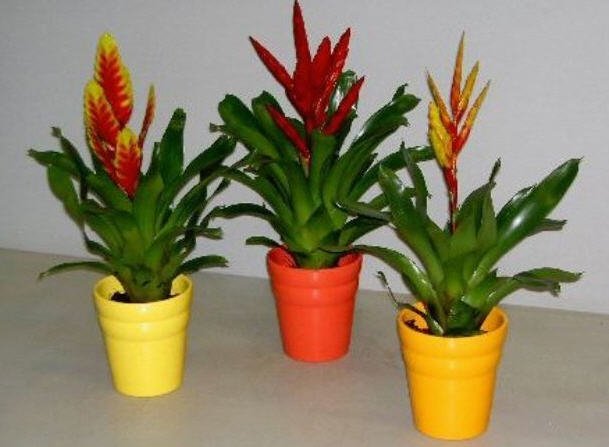
Bright ceramic vriezia planter is decorative and adds resilience to the plant
Composing the potting soil
The substrate for Vriezia must be loose and nutritious. Specialty bromeliad primer, which can be found commercially, works well.
For those who prefer to make the potting mix with their own hands, we recommend using:
- 2 parts of sod land;
- 1 part peat;
- 1 piece of leafy land;
- 1/3 of coarse sand;
- 1 part mixture of charcoal, pine bark and sphagnum moss.
Transplant secrets
Vriezia tolerates transplantation very badly; after the procedure, the flower gets sick and stops developing. Because of this feature, the event is recommended to be held only in two cases: after buying a plant in a store and when breeding vriezia.
When purchasing a non-flowering Vriese, allow it to adapt to your home environment. This period will take about two weeks. Then transplant the plant using the transfer method. Blooming vriezia should not be transplanted, as this threatens with loss of flowers and even death. Wait for the vriezia to bloom, and it will have lateral shoots that can be transplanted.
How to transplant Vriezia
Pour expanded clay into the selected container 1/3 of its volume. This will save vriezia from stagnant water, and the roots will receive additional aeration.
Add a handful of charcoal to prevent infection and soil acidification.
Pour a layer of soil on the drain, which is 1/3 the volume of the flower pot.
Very carefully, taking care not to damage the roots, remove the vriezia from the old pot.
Place the plant in a prepared container and add soil.
Do not compact the substrate so that it is evenly distributed, shake the pot.
Pour the planted vriezia into the center of the outlet and place in a warm place.

After transplanting, place the plant in a warm place.
How does it multiply
Reproduction of vriezia can occur either from seeds or vegetatively.
Seed propagation
Growing Vriezia from seeds is a long and laborious process. And it is not a fact that it will end with the germination of a plant. It is almost impossible to buy seeds from sellers. Growing this plant at home from seeds is mainly engaged in breeders.
In this case, you should adhere to the basic rules:
- Cultivation of vriezia from seeds and care at home should take place at a temperature not lower than 21-22 ° C. Keep the seed container out of direct sunlight.
- For cultivation, a soil mixture with a light structure is chosen, best of all based on sphagnum.
- During germination, make sure that the soil does not dry out.
The first shoots appear four months after sowing the seeds. After six months, the plant can be transplanted into a large container or pot.
Note! The first year in the life of Vriezia is very important - it should be kept in places with a constant temperature of at least 15 ° C, regularly sprayed and watered
Vegetative propagation
Reproduction by offspring is the most effective way of breeding Vriezia at home. To do this, when offspring appear on the plant, they must be carefully pinched off and placed in separate pots each for further germination.
You can create a greenhouse effect for them - covering them with plastic wrap or glass. But at the same time, one must not forget to often ventilate the plants. As soon as the sprouts get stronger, the coating is removed, and they are cared for as for adult plants.
How to determine that the babies can already be separated from the main plant and planted in a separate container? This is not difficult - the baby should be at least 1/3 of the size of the mother plant in size. At this time, the root system is actively forming and the young plant is ready for independent life.
Reproduction
Vriezia propagates in two ways: lateral shoots and seeds. At home, Vriezia is almost always propagated by lateral shoots. After flowering, the mother plant begins to die off, but at the same time it gives life to young plants. Do not rush to transplant them.
Roots should form on the side shoots. In addition, young plants must necessarily reach half of the growth of the mother plant. This process can take 8 to 12 months. Experienced growers recommend starting the rooting process of lateral shoots no earlier than 2 years after the start of their formation. During this time, the children will become quite strong and acquire their own root system.
Reproduction by shoots - a step-by-step process
- Carefully remove the mother plant along with the side shoots from the pot.
Mother plant with lateral shoots - Free the roots from the soil by rinsing them in water.
- Use a sharp knife to separate the shoots from the old plant so that each shoot has roots.
- Sprinkle the slices with crushed charcoal.
- Treated shoots should dry out for about a day.
- Pour a layer of drainage and soil into the prepared pot.
- Place the side shoot in the center and fill up the rest of the soil.
Rooted lateral shoots of vriezia.
A planted Vriezia shoot needs warmth, so we cover the pot with a mini greenhouse or a glass jar, keeping the temperature inside at 26 - 28 degrees. After a month, you can do small airings, gradually increasing the time the plant stays outside the greenhouse. After another month of hardening, the greenhouse can be removed completely.You can transplant a young plant in a year. Young Vriesias are cared for like adults.
Seed propagation is most often used in the greenhouse industry. This method does not guarantee success; moreover, it is very laborious. It is very difficult to obtain plant seeds at home. To do this, you need to use artificial pollination - with the help of a soft brush, transfer the pollen of one flower to another. If you succeed, then you can try to get new plants from seeds.
Seed germination process
- Wait for the seed box to dry and crack.
- The extracted seeds are left in a warm place to dry for a day (avoid sunlight).
Vriese seeds - Before sowing, treat the seeds in a weak solution of manganese or fungicide and dry.
- Pour a disinfected mixture of equal parts of peat and sand into a container for germination.
- Spread the seeds evenly on the prepared soil mixture.
- Moisten evenly with a spray bottle and cover with plastic wrap or glass.
- The temperature inside the shelter should be 25 degrees.
- Ventilate and moisten the seedbed periodically.
- If all norms are observed, shoots will appear in about a month.
- After the appearance of the third true leaf, make a pick into separate pots.
- After 6 months, repot the plant again and care for it as if it were an adult.
A plant bred from seeds does not retain varietal characteristics. In addition, it will take a long 5 years to wait for flowering, possibly longer.
Disease and pest control and prevention (table)
Problem Symptoms Prevention and Treatment Scabbard Brown bumps appear on the leaves. The leaves are withering.
- Treat with Aktellik or Aktara - 15 -20 drops per 1 liter of water.
- If there are not very many scabbards, it can be removed mechanically - with a napkin dipped in a mild soapy solution. After 3 - 4 days, repeat the procedure until the pest is completely eliminated.
- Folk remedies - tincture of onion peel or garlic arrows.
Mealybug
- On the leaves, and especially in the axils, fluffy lumps of white appear.
- The ornamental qualities of the plant deteriorate.
- Leaves are deformed, dry and fall off.
- Processing Aktara, Fitoverm according to the instructions.
- With severe damage, treatment with an emulsion of karbofos is indicated.
Red spider mite
- The leaves are covered with thin filaments, resembling a cobweb, on which whitish dots are visible.
- A colony of ticks sucks out the juices from the plant, and the plant begins to stagnate.
- A plant affected by a tick is treated with Decis or Zolon.
- If there are many pests, the plant can be washed under a warm shower.
- For prophylaxis, the plant should be moistened with warm water more often.
Root worm On the roots, especially at the root collar, ovipositions are formed. Roots rot.
- The root system is checked annually in the spring.
- Watering decreases.
- If a pest is detected, the plant is treated with a 3% solution of Karbofos or Fazalon.
- In case of very severe damage, the plant is best destroyed.
Leaf spot is a fungal disease that affects the leaves. They become covered with small, rounded transparent blisters. Then the affected areas are covered with gray-black stripes.
- Spray with fungicide.
- Adjust watering.
- When the form is neglected, the plant is destroyed.
How to plant correctly?
After buying a vriezia, it is imperative to transplant it correctly. To do this, you will first need to correctly select a suitable pot. The vessel must meet the following requirements.
- The height of the container should not be very large - no higher than 15 cm. The top should be wide. The volume should correspond to the size of the root system of the sprout.
- The vessel must have drainage holes.
- Better to take a ceramic pot. The plastic container can tip over due to the weight of the plant.
- If you bought a plastic pot, then it is advisable to insert it into a ceramic pot for stability.

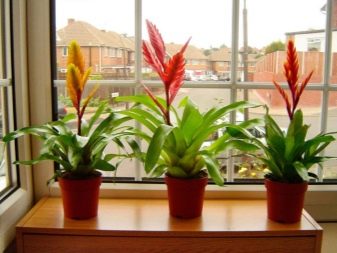
The substrate in which you plan to grow the flower should be loose and nutritious. It is permissible to use a ready-made mixture from the store shelf, intended exclusively for bromeliads. And you can make the substrate yourself. To do this, take the following components:
- sod land - 2 parts;
- special fibrous peat - 1 part;
- sheet land - 1 part;
- coarse sand - 1/3 part;
- small amount of charcoal.
Having prepared all the necessary components, you can proceed to the direct planting of a tropical bright flower. It should be borne in mind that Vriezia itself "does not like" this procedure very much. After it, the plant will not fully develop for a long time. The development of the root system will become noticeably slower, which is why it is customary to plant a ripe flower in a new place no more than once every 3-5 years. A transplant is required in 2 main cases:
- in order to reproduce a flower;
- if you purchased Vriezium in shipping soil.
The acquired plant, if it does not bloom, must go through an adaptation period of about 2 weeks. After that, it can be transplanted, because transport soil is not the best solution for this flower.

It is advisable to transplant Vriezia during active growth, that is, in the spring or at the very beginning of summer. Let's consider step by step how to properly plant a vriezia.
- Pour drainage (from broken shards and expanded clay) into the purchased pot by 1/3. Add charcoal to it, which will prevent the soil from souring.
- Next, fill in a layer of soil. It should take up about the same volume as drainage.
- Remove the vriezia from the old pot as carefully as possible. Be careful not to damage the roots. Place the flower in a new container.
- Set the plant in a new place and fill it with soil.
- So that the soil crumbles correctly, knock the pot on the table without any extra effort. When the soil settles, it will be possible to add more.
- You can lightly crush the top of the ground with your fingers. But you don't need to press hard, so as not to harm the roots.
- Move the plant to a warm, draft-free area with plenty of light. Water the outlet.

For information on how to transplant Vriezia, see the next video.
Pests and diseases
Diseases for vriezia splenriet, which were properly cared for, are not typical. However, if the conditions for development are violated, the following can be observed:
- reduced air humidity, excessive watering - discoloration of leaves, retardation of development and growth;
- burns from ultraviolet radiation - the appearance of pale and brown spots;
- hard water - the tips of the foliage turn black;
- lack of irrigation - the leaves dry and turn black;
- exposure to cold air - wilting, inflorescences disappear, leaves become thinner;
- excessive watering or improper cut of children for planting - decay and death of the flower;
- insufficient light baths - faded and faded buds;
- fungal infection is observed with gray spots, often associated with intensive watering of the plant.
Among pests, vriezia splenriet can be attacked by: bromeliad, palm, comb and black scale insects, red spider mites, mealy, bristly and root bugs.
| Growing | A light-loving and heat-loving plant requires a relatively constant temperature throughout the year: not lower than + 17 ° С and not higher than + 25 ° С. You need bright, sunny lighting, or artificial lighting. |
| Humidity | Elevated or high, about 70-80%. In summer, the soil is kept moist, pouring water directly into the plant outlet every 3 days, in winter it is watered moderately, allowing the soil to dry out slightly between waterings. |
| Top dressing and pruning | Before flowering, fertilize with a weak solution of any complex preparation, during the rest period, feeding is not carried out. It is necessary to prune the plant from wilting inflorescences and dried foliage tips as needed. |
| Flowering period | Depending on the time of planting, the vriezia flower at home can bloom in February-April or May-July. |
| Landing, transplanting | After acquisition, subsequent transplants are combined with the separation of children. They are planted in soil for bromeliads or prepared independently from leaf humus, peat, sand, pine bark and moss. |
| Reproduction | By shoots or dividing the bush. |
| Pests | Bromeliad scale insect, mealybug, spider mite. |
| Diseases | Diseases are caused by violations of the rules of plant care - mold, rot of the root system, fungal infections. |

